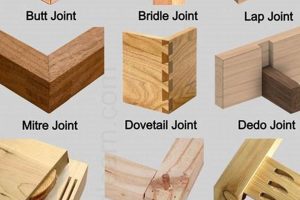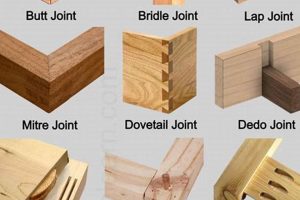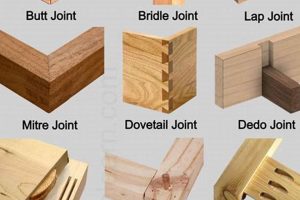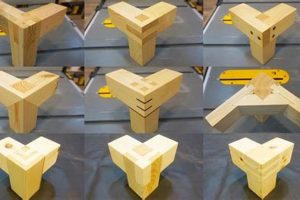
The utilization of threaded fasteners to connect pieces of wood forms a crucial category within joinery. These connections, characterized by their mechanical strength and ease of assembly, involve the insertion of a... Read more »

A connection formed between two or more pieces of wood, utilizing various techniques to ensure structural integrity and aesthetic appeal, is essential in woodworking. These connections range from simple, easily executed methods... Read more »

The methods by which pieces of wood are connected to form a structure represent a fundamental aspect of woodworking. These connections, crucial for the integrity and aesthetics of the final product, range... Read more »

A specific type of wood joinery involves connecting three separate wooden pieces at a single corner point. This construction technique is frequently employed in furniture making, frame construction, and other woodworking projects... Read more »

Connections in woodworking are fundamental to creating stable and aesthetically pleasing structures. These connections, achieved through various methods, unite individual pieces of timber to form a cohesive whole. Dovetails, mortise and tenons,... Read more »
![Top Rated: Best Woodworking Jointer [Buyer's Guide] Step-by-Step Guides, Tools & Inspiration to Build Beautiful Wooden Decor on a Budget Top Rated: Best Woodworking Jointer [Buyer's Guide] | Step-by-Step Guides, Tools & Inspiration to Build Beautiful Wooden Decor on a Budget](https://woodfromhome.com/wp-content/uploads/2025/09/th-660-300x200.jpg)
A woodworking jointer, often regarded as an essential stationary power tool in a cabinet shop, is used to create perfectly flat and square edges on boards. This machine ensures that two adjoining... Read more »

A device used in woodworking to create accurate and repeatable joinery. These tools guide cutting implements like routers, saws, or drills, ensuring consistent angles and depths for various connection types. For instance,... Read more »

A pivotal element in woodworking, this connection allows for circular movement between two or more wooden components. Common examples include swivel joints in chairs, rotating shelves, or mechanisms for adjusting the angle... Read more »

Connections are fundamental to the structural integrity and aesthetic appeal of wood constructions. These articulations, formed by interlocking or adhering separate pieces, enable the creation of complex forms and robust frameworks. A... Read more »

The methods of connecting pieces of wood are crucial to the structural integrity and aesthetic appeal of any woodworking project. These connections, achieved through various techniques, allow for the creation of complex... Read more »


